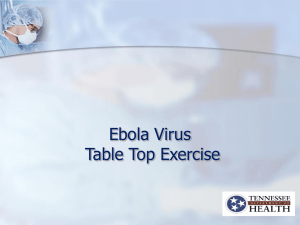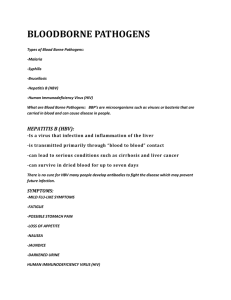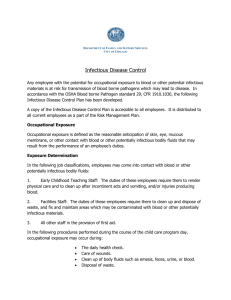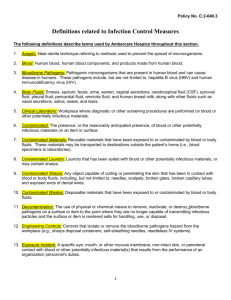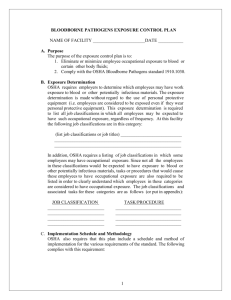EMS Special Considerations
advertisement
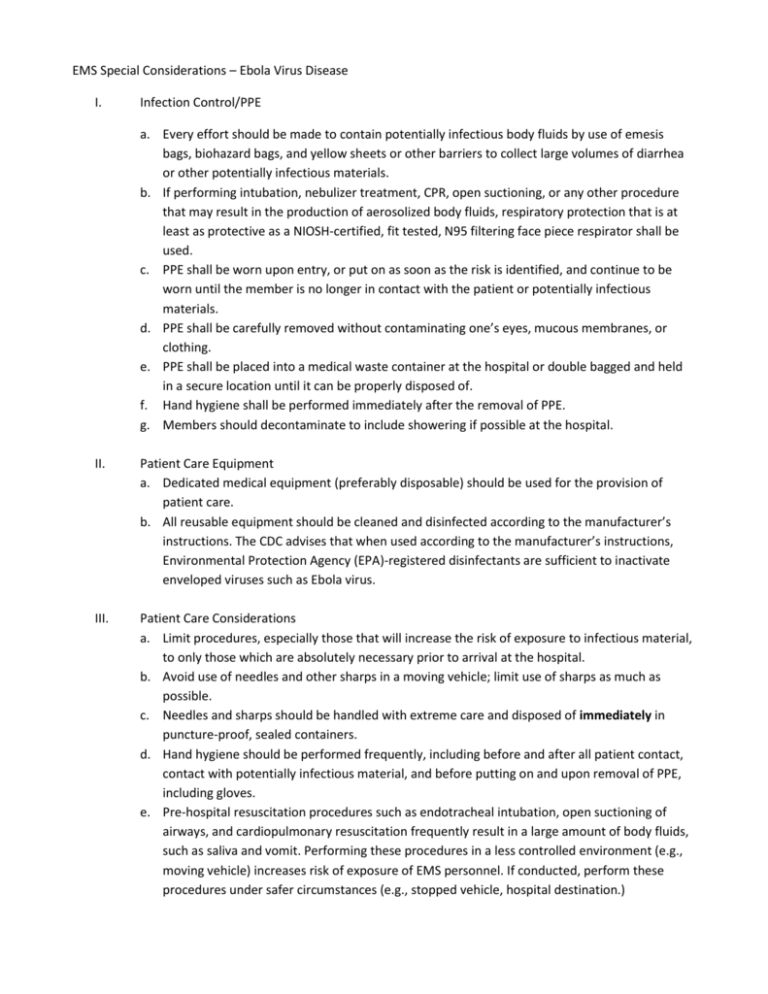
EMS Special Considerations – Ebola Virus Disease I. Infection Control/PPE a. Every effort should be made to contain potentially infectious body fluids by use of emesis bags, biohazard bags, and yellow sheets or other barriers to collect large volumes of diarrhea or other potentially infectious materials. b. If performing intubation, nebulizer treatment, CPR, open suctioning, or any other procedure that may result in the production of aerosolized body fluids, respiratory protection that is at least as protective as a NIOSH-certified, fit tested, N95 filtering face piece respirator shall be used. c. PPE shall be worn upon entry, or put on as soon as the risk is identified, and continue to be worn until the member is no longer in contact with the patient or potentially infectious materials. d. PPE shall be carefully removed without contaminating one’s eyes, mucous membranes, or clothing. e. PPE shall be placed into a medical waste container at the hospital or double bagged and held in a secure location until it can be properly disposed of. f. Hand hygiene shall be performed immediately after the removal of PPE. g. Members should decontaminate to include showering if possible at the hospital. II. Patient Care Equipment a. Dedicated medical equipment (preferably disposable) should be used for the provision of patient care. b. All reusable equipment should be cleaned and disinfected according to the manufacturer’s instructions. The CDC advises that when used according to the manufacturer’s instructions, Environmental Protection Agency (EPA)-registered disinfectants are sufficient to inactivate enveloped viruses such as Ebola virus. III. Patient Care Considerations a. Limit procedures, especially those that will increase the risk of exposure to infectious material, to only those which are absolutely necessary prior to arrival at the hospital. b. Avoid use of needles and other sharps in a moving vehicle; limit use of sharps as much as possible. c. Needles and sharps should be handled with extreme care and disposed of immediately in puncture-proof, sealed containers. d. Hand hygiene should be performed frequently, including before and after all patient contact, contact with potentially infectious material, and before putting on and upon removal of PPE, including gloves. e. Pre-hospital resuscitation procedures such as endotracheal intubation, open suctioning of airways, and cardiopulmonary resuscitation frequently result in a large amount of body fluids, such as saliva and vomit. Performing these procedures in a less controlled environment (e.g., moving vehicle) increases risk of exposure of EMS personnel. If conducted, perform these procedures under safer circumstances (e.g., stopped vehicle, hospital destination.) IV. V. Patient Transport into Hospital a. Contact the Medical Control/Dispatch as soon as the patient has been identified as a potential Ebola risk. The Medical Control/Dispatch shall immediately notify the receiving hospital in order to prepare for patient arrival. Any hospital that is following CDC’s infection control recommendations and can isolate a patient in a private room is capable of safely managing a patient with Ebola. b. Medical Control/Dispatch shall contact the local health department/health authority. c. Upon arrival at the receiving facility, transporting crew members shall remain inside the vehicle with the patient, until directed to unload by hospital receiving staff. d. The transfer of patient care will occur at the back doors of the ambulance. This will allow the hospital to control the movement of suspect EVD patients into hospitals or healthcare facilities. Potential Ebola patients should be restricted to entrances away from public waiting areas. e. Suspected EVD patients should not be moved through, or temporarily left in, waiting rooms. f. If the patient, stretcher, members’ PPE, or other items or equipment is contaminated with potentially infectious material, members shall take care to minimize the transfer of potentially infectious material to hospital surfaces. Environmental Cleaning a. Diligent environmental cleaning and disinfection and safe handling of potentially contaminated materials is extremely important, as blood, sweat, emesis, feces and other body secretions represent potentially infectious materials. b. Persons performing environmental cleaning and disinfection shall wear recommended PPE to protect against exposure through contact and/or splashes during clean-up: i. Gloves ii. Gown (fluid-resistant or impermeable) iii. Goggles iv. Facemask v. Additional PPE may be required in certain situations, including the presence of copious amounts of blood, other body fluids, vomit, or feces on the patient or in the environment. In these cases, member shall use the following additional PPE as needed: 1. Double gloving 2. Disposable shoe covers 3. Leg coverings 4. Tyvek body suit- This is not essential to provide care to suspected EDV patients, but it may be more practical than using a gown with separate coverings for the legs and shoes. c. Patient-care surfaces (stretchers, railings, medical equipment control panels, and adjacent flooring, walls, and work surfaces) are likely to become contaminated and shall be cleaned and disinfected immediately after transport. Hospital-grade agency supplied disinfectants, when used according to the label, are sufficient to kill Ebola. d. A blood spill or spill of other body fluid or substance should be managed according to agency’s Infection Control Guidelines. VI. e. Contaminated reusable patient care equipment shall be placed in biohazard bags and labeled for cleaning and disinfection according to agency policies. Reusable equipment should be cleaned and disinfected according to manufacturer’s instruction by trained personnel wearing correct PPE. f. To reduce exposure among staff to potentially contaminated textiles (cloth products) while laundering, discard any contaminated fabrics (including uniforms), linens, and non-waterproof pillows or mattresses as regulated medical waste. i. If proper PPE is utilized, members’ uniforms should not be contaminated with potentially infectious material. g. Ensure that infectious waste is safely contained in clearly marked biohazard bags/containers and disposed of in compliance with agency’s guidelines. Follow-Up and Reporting Measures After Caring for Suspected or Confirmed Ebola Patient a. EMS Personnel with exposure to blood, bodily fluids, secretions, or excretions from a patient with suspected or confirmed Ebola shall immediately: i. Stop working and wash the affected area with a large amount of water or eyewash solution; ii. Contact the Supervisor for assessment and access to post-exposure management services; and iii. Receive medical evaluation and follow-up care, including fever monitoring twice daily for 21 days, after the last known exposure. The member may continue to work while receiving twice daily fever checks, based upon recommendations from local, state, and federal public health authorities. b. EMS personnel who develop sudden onset of fever, intense weakness or muscle pains, vomiting, diarrhea, or any signs of hemorrhage after an unprotected exposure (i.e., not wearing recommended PPE at the time of patient contact or through direct contact to blood or body fluids) to a patient with suspected or confirmed Ebola should: i. Not report to work or immediately stop working and isolate themselves; ii. Notify their supervisor, who should notify local and state health departments; iii. Contact physician through Workers’ Compensation for assessment and access to postexposure management services; and iv. Comply with work exclusions until they are deemed no longer infectious to others.


